I've always believed that when we travel to new places our minds seek out the strange and weigh it against the familiar. To me, this is an automatic reflex. Subtleties come later. Naturally, this is what I began to do when I arrived in Adelaide. 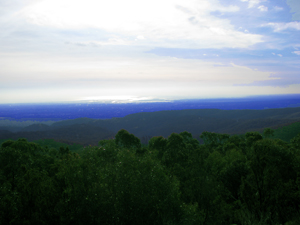
On the way from the airport, there were the familiar fast food logos. The shape of the Burger King sign was instantly recognizable. But here it's called Hungry Jacks. The golden arches bear the name McDonalds but, here, the colloquialism is not "Mickey D's" but "Macca's," a nickname I thought was reserved for Paul McCartney.
The language differences between Australia and the US are marked. There is a pervasive tendency here to shorten words. There is "barbie" for "barbeque." "Football" becomes "footie." "Breakfast" is "brekkie." "Registration" is "rego." "Woolworth"s" -- one of the largest grocery store chains there -- is "Wooly's." In the casino a slot machine is called a "pokey" machine --short, one assumes, for poker though there is no video poker, just slots. "Australia" itself is "Oz" and people who live there are "Aussies."
You hear these diminutives on the streets, from announcers on TV and see them on signs. You get used to it.
Among the specialty foods you can get here are kangaroo steak (I couldn't do it) and the native Barramundi fish, which Dr. Oz recently proclaimed a "super food." The chocolate -- Haigh's is produced locally in Adelaide -- is, as it is in the UK, noticeably richer than we get in America. For proof, buy a Cadbury bar at home and bring with you. Once there, buy another. Taste each. The difference is obvious and, if you buy your chocolate in the USA, disheartening.
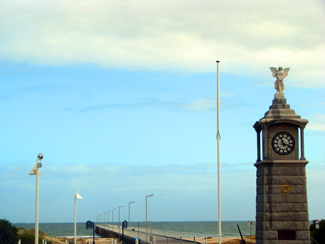 There are beautiful beaches in the Adelaide region. Glenelg boasts nice sand and waterside shops, restaurants and lots of room to relax. At the aforementioned Port Adelaide area of the city there are lovely seaside homes and shopping. Near the port is Semaphore. This is a small (under 3,000 people) community with heaps of amenities and Semaphore Beach (photo at right).
There are beautiful beaches in the Adelaide region. Glenelg boasts nice sand and waterside shops, restaurants and lots of room to relax. At the aforementioned Port Adelaide area of the city there are lovely seaside homes and shopping. Near the port is Semaphore. This is a small (under 3,000 people) community with heaps of amenities and Semaphore Beach (photo at right).
Adelaide is a lovely city with lots of land devoted to parks and surrounded by the Adelaide Hills. This is also wine country, with vineyards in the nearby valleys and the University of Adelaide's National Wine Centre of Australia in the city. Here you can find an interactive "Wine Discovery Journey" that takes you on all the steps from grape to glass. There is also ample opportunity for wine tasting.
Also in the city you can shop in JamFactory, a crafts collective in which local artisans display their wares and where they may create goods to sell. JamFactory has studios for ceramics, glass, furniture and metal design, offering classes, associates degree programs, artists-in-residence and, of course, a shop. Anyone in Adelaide looking for handcrafted works would do well to visit JamFactory.
You can take some time to travel to Mt. Lofty, the aptly named highest point in the region. On a clear day the visitor can see Kangaroo Island (98.4 miles distant) from the summit of Mt. Lofty.
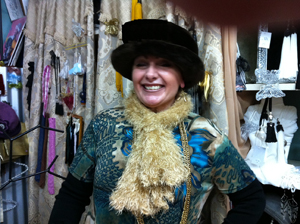 Just outside the city, near Mt. Lofty, you can visit the town of Hahndorf, settled by German Lutheran immigrants in 1939. Although ist is known as a German town, it was named after Captain Dirk Meinhertz Hahn, the Danish captain of the boat that brought them to Australia, While Hahndorf retains much of its old world ambiance and you can get a traditional German meal there, you can also dine on a great pizza. Shopping there is good, too. There is a shop devoted to natural balms and unguents for healthy skin. There's another that deals in tassels.
Just outside the city, near Mt. Lofty, you can visit the town of Hahndorf, settled by German Lutheran immigrants in 1939. Although ist is known as a German town, it was named after Captain Dirk Meinhertz Hahn, the Danish captain of the boat that brought them to Australia, While Hahndorf retains much of its old world ambiance and you can get a traditional German meal there, you can also dine on a great pizza. Shopping there is good, too. There is a shop devoted to natural balms and unguents for healthy skin. There's another that deals in tassels.
Georgia (that's pronounced "Geor-gee-ah") Shikritzhs makes pins, earrings and other assorted jewelry, but her specialty is tassels in all sizes and colors. Greeting shoppers bedecked and bedazzled with her wares, she is, from all evidence, the local character. Shakritzhs doesn't use the internet or email. She sells only to those who happen into her store.
Tassels, she explains to the visitor, have been her passion since she first made them in the 1980s. She finally settled in Hahndorf and her shop, Fantassel, is unique in the country. It features handmade items from women who, she says, "are as passionate about what they do as I am about what I do." If the visitor to her shop is a woman, she tends to address her as "kind lady" and takes care to wrap every purchase most prettily. It is a shop worth a visit and a shop owner worth meeting.
Sharing real estate with Mt. Lofty is Cleland Conservation Park. It was here that I saw those fantastical creatures that, of course, I knew existed but that I never quite believed were real.
Like many non-Aussie kids, my first information about kangaroos came from a book called Katy No-Pocket b Emmy Payne, illustrated by A.H. Rey, who did the art for the Curious George books. This 1944 story tells of Katy, a kangaroo who is sad because she doesn't have a pouch in which to carry her baby, her Joey. A nice carpenter helps her out by giving her a carpenter's apron and all ends well. I had the book when I was a child and I bought it to read to my children. And, since I was first told Katy's story, kangaroos tended to be creatures of fiction. Even seeing them in the zoo, they remained a bit unreal.
So, now, here I am at Cleland Conservation Park and I am feeding a kangaroo. Silly as that may be, it was an amazing thing to me. It was like seeing the laser show at the Sphinx. I kept thinking "I am actually in the Sahara and that is really the Sphinx in front of me." It was difficult to wrap my mind around the fact that after years of reading about it, I was this close to the Sphinx. So it was with the kangaroos.
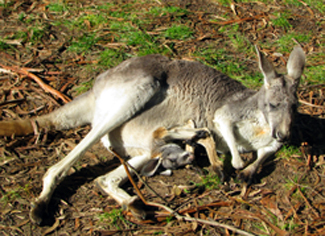 And, then, as we were feeding one female -- you can tell she's a female because the males are larger and redder in color -- there was a ripple in her belly. We looked more closely and there was a teeny little paw where the ripple was. This was a kangaroo carrying her joey and the baby was about to leave the comfort of the pouch.
And, then, as we were feeding one female -- you can tell she's a female because the males are larger and redder in color -- there was a ripple in her belly. We looked more closely and there was a teeny little paw where the ripple was. This was a kangaroo carrying her joey and the baby was about to leave the comfort of the pouch.
These kangaroos, accustomed to people and very tame, made little noises and were gentle even when more than one of them wanted the food pellets you held. It was unforgettable.
We also got to pet Koalas and see Dingos lazing around on the grass. (By the way, Australians don't like jokes about dingos eating things, so don't try on your best Aussie accent and say that "the dingo ate my baby.")
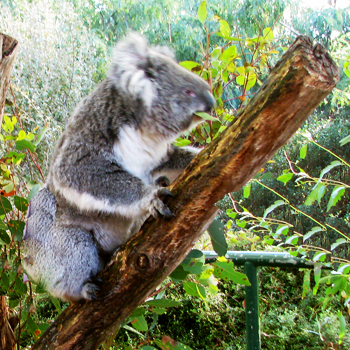
Becky, the Koala we could pet just kind of sat, calmly tolerating our friendliness. Her compatriots were in a large cage, happily munching on eucalyptus leaves. These are not, despite popular nomenclature, bears. What they are is absolutely adorable.
We saw other marsupials, Possums and Bandicoots that were walking around Cleland. Behind a fence we found a Tasmanian Devil, a vicious, dangerous thing that moves very quickly. We also saw some wombats -- the regular" kind and hairy-nosed variety. These, too, are kept behind fencing as they've been known to attack humans.
There was much to see in Adelaide, a wonderful city where friendly Aussies and keep the devils at bay.
All photos by author.